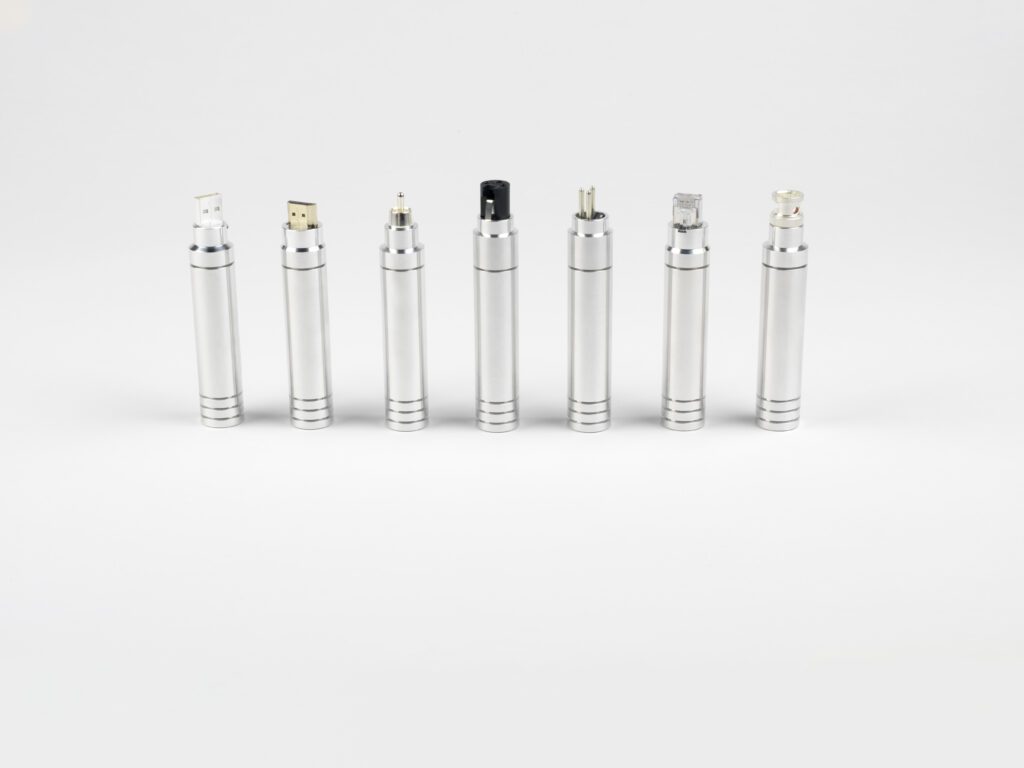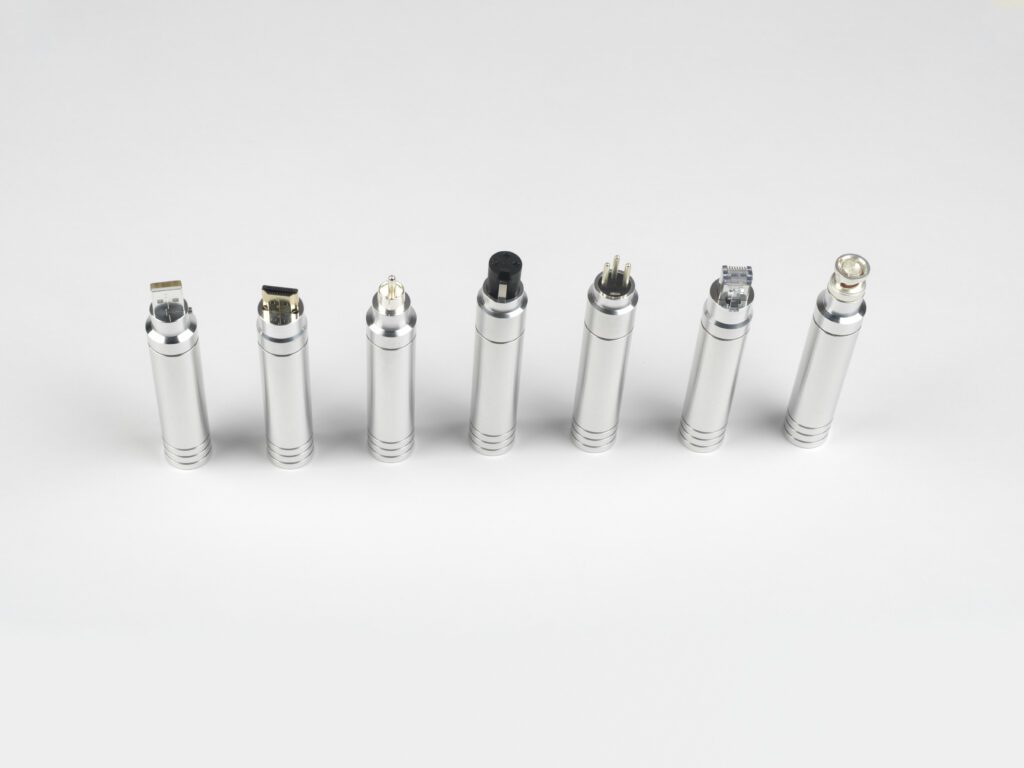World News
Chord Company GroundARAY
When you look at Chord Company, you tend to think about cables… largely because for decades the company has focused almost exclusively on digital and analogue interconnects, power cords and loudspeaker cables. But as an example of just how far Chord Company has come in recent months, the GroundARAY line of noise reduction devices is an entirely new venture for the company. OK, so Chord Company isn’t the first brand to toy with the concept of parallel grounding as overall noise reduction – there are devices from Tripoint, Entreq, CAD, Nordost and more that run along the same lines – but GroundARAY arguably makes the concept considerably more practical!
Going to Ground
Where most of the aforementioned grounding systems rely on a standalone box that connects to spare connectors on a piece of electronics, GroundARAY is a small, cylindrical per-unit device that plugs into the back panel of your electronic device. Each one costs the same £550 (because they are effectively the same grounding device with a different termination).
GroundARAY is a 10cm long aluminium tube with the words ‘Chord GroundARAY’ laser etched along the side and Chord’s logo on its end. The dealer demo pack – with five of them in a black box – looks like the McGuffin in a Mission Impossible movie. In systems where shelf space is at a premium, bringing the grounding solution to the component is less problematic than devoting a whole shelf to an earthing box. Just remember you need at least 10cm behind the product.

Pragmatically speaking, that’s a bonus to GroundARAY that no audio reviewer will ever fully understand; it flies under the radar. A parallel grounding system is very noticeable when you add it; there are boxes and wires everywhere, which are all too easy to spot by non-audiophiles. These can do their stuff, safe in the knowledge that you don’t have to justify their existence. Whether that justification is familiar scrutiny or peer pressure, GroundARAY’s ‘behind the product invisibility’ is a boon.
The ‘secret sauce’ inside the GroundARAY remains secret but is said to be a series of absorption devices, using materials chosen for the specific task. This provides a low-impedance pathway for high-frequency noise, wicking away noise from the signal ground of the device to which the GroundARAY is connected. Were it not that it sounds like Gothic horror, GroundARAY is like a little tube of deadness for your audio system, and the more products that receive the GroundARAY treatment, the more the effect becomes noticeable.
How it works is simple. Borrow a dealer demo box. Listen to your system without them. Put one in a spare BNC, XLR, or RJ45 connector on your DAC or streamer. Listen again. Then do the same in an RCA or XLR socket in your amplifier. Listen a third time. Then whip them all out and give your system a final confirmatory listen with all the GroundARAYs taken out of the loop. Repeat the whole process a second time because you can’t quite believe what you heard the first time. When you hand back the demo box, you find your credit card has accidentally fallen into the dealer’s card reading machine and, well, while it’s there, you might as well order a few.
Grounded in sound
Given Chord Company’s suggestion that these are ‘noise reduction’ devices, the logical place to go looking for sonic differences would be in the noise floor, and yes, those silences are some of the most silent silences I’ve never heard. But that’s only the start of the story; what GroundARAY is so adept at controlling is noise in the high frequencies. This makes audio electronics – especially digital audio electronics and in particular streaming devices – sound less gritty, grainy, hashy and harsh. The sound of almost any instrument loses a lot of that electronicky sheen that has so often been the reason why people still shun digital in favour of analogue devices like record decks. That analogue-like purity of tone and clarity of tonal colour is better resolved with the addition of the GroundARAY.
Of course, this is most telling with female vocals – Joyce DiDonato’s pure mezzo-soprano tone and her coloratura vocal talents benefit greatly from the GroundARAY treatment – but perhaps what’s most surprising is just how much it makes every recording sound that bit more like the real deal. Graunching guitars snap into sharp focus while sounding powerful and loud.
Recordings made in small clubs sound atmospheric to the point where you can almost feel your clothes saturated with cigarette smoke. Meanwhile concerts in large church halls and concert halls ‘scale’ easier to simulate that large soundstage. It doesn’t matter the size of the system; I played all this through a pair of KEF LS50 Meta, and the resolution of space and size was still present.
Ground around
Move from one GroundARAY to multiple, and the effect increases significantly. It’s not an exponential increase; more improvements in air and space around the instruments. But it is easy to hear and universally positive. As stated earlier, the demo devices don’t need to spend much time out of the box before you are won over.
The joy of multiple GroundARAYs is in the way it fills in the rest of the listening experience. This varies from person to person, but, if you like what one GroundARAY does to your personal choice of music, more of them expand your musical options. The process of making treble and midrange sound more like they do when you are at a live event is a heady one, and the more GroundARAY you bring to the party, the more of a party it gets. Just without the hangover the next day.

I still maintain the first date in your GroundARAY relationship is with digital audio, but that does come with a caveat. I think there’s a relationship between the noise these devices are trying to cancel and switch mode power supplies. If you are using an amplifier that relies on switch-mode power, GroundARAY’s impact on the sound is more significant. This might also explain why the GroundARAY works so well with digital devices as they almost universally come with switch-mode juice boxes.
There’s one last point; does GroundARAY play nice with the other grounding devices? I’m slightly limited here to a sample of one (the Nordost QKore), but I’m happy to report that they both work well together and complement one another rather than double up (or worse, cancel out) their effects. QKore acts more on soundstage width, bass definition and noise floor reduction, with some benefits in higher frequency performance, whereas GroundARAY is more about making those higher frequencies as clean as possible and extending that naturalness and clarity down the frequency range and out into the soundstage. And, of course, reducing the noise floor.
You’re Grounded!
As with all grounding devices, the system and environment play their part. We live in a soup of Wi-Fi, and our power lines sing to the tune of switch-mode power supplies on everything from phone chargers to computers, but the degree of impact of those things does vary; if you are living cheek-by-jowl in the big city, those problems are more directly noticeable than if you are miles from your nearest neighbour. Similarly, a system that remains solely LP-oriented and the nearest it gets to modernity is a power-on LED might not hear so profound a difference from GroundARAY. All I can say is in West London with a system that has a streamer. The results were compelling.
The biggest problem is perhaps the bitterest pill of all; supply. The reason we took so long in getting this next generation of Chord Company’s products is not through some angry staring out contest between us; it was that almost everyone who borrows a dealer Demo kit ends up buying at least one GroundARAY and the orders have stacked up. After that home demonstration, you might find yourself on a waiting list for your shiny tubes of pleasure. And that’s frustrating because once you hear what Chord Company’s GroundARAY does, you want it. Now!
Price and Contact Details
- GroundARAY £550
- Available in RCA, BNC, XLR (male and female), DIN, USB, RJ45 and HDMI connections
Manufactured by
The Chord Company
+44(0)1980 625700
The post Chord Company GroundARAY appeared first on Hi-Fi+.
-
Product on sale
 Audiophile Vinyl Records Cleaning BundleOriginal price was: €50.00.€40.00Current price is: €40.00. excl. VAT
Audiophile Vinyl Records Cleaning BundleOriginal price was: €50.00.€40.00Current price is: €40.00. excl. VAT -
Product on sale
 Easy Start Vinyl Records Cleaning KitOriginal price was: €50.00.€40.00Current price is: €40.00. excl. VAT
Easy Start Vinyl Records Cleaning KitOriginal price was: €50.00.€40.00Current price is: €40.00. excl. VAT -
Product on sale
 Vinyl Records Cleaner Easy Groove ConcentrateOriginal price was: €35.00.€25.00Current price is: €25.00. excl. VAT
Vinyl Records Cleaner Easy Groove ConcentrateOriginal price was: €35.00.€25.00Current price is: €25.00. excl. VAT -
 Easy Groove Super Set€199.00 excl. VAT
Easy Groove Super Set€199.00 excl. VAT -
Product on sale
 Easy Groove Enzycaster – vinyl records prewash cleanerOriginal price was: €35.00.€25.00Current price is: €25.00. excl. VAT
Easy Groove Enzycaster – vinyl records prewash cleanerOriginal price was: €35.00.€25.00Current price is: €25.00. excl. VAT -
Product on sale
 Easy Groove Spray&Wipe vinyl records cleanerOriginal price was: €35.00.€25.00Current price is: €25.00. excl. VAT
Easy Groove Spray&Wipe vinyl records cleanerOriginal price was: €35.00.€25.00Current price is: €25.00. excl. VAT






